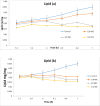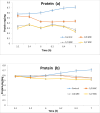RED light promotes flavonoid and phenolic accumulation in Cichorium spp. callus culture as anti-candida agent
- PMID: 39820743
- PMCID: PMC11739635
- DOI: 10.1038/s41598-024-85099-0
RED light promotes flavonoid and phenolic accumulation in Cichorium spp. callus culture as anti-candida agent
Abstract
Chicory species, particularly Cichorium endive Supp. Pumillum, also, known as Egyptian chicory, are globally recognized for their rich content of bioactive secondary metabolites such as flavonoids and phenolics. These metabolites are highly valued for their pharmaceutical, dietary, and commercial applications. Light exposure, particularly through red and blue wavelengths, is a potent natural elicitor that influences the biosynthesis of secondary metabolites and impacts plant morphology. This study investigates the effects of red and blue LED light exposure on the callus culture of Egyptian chicory (Cichorium endive Supp. Pumillum), with the aim of enhancing flavonoid accumulation for potential use as an anti-Candida agent. Callus cultures of Cichorium intybus, Cichorium endive Supp. Pumillum, and Taraxacum officinale (Italian chicory) were grown on MS media supplemented with 4 mg/L 2iP and 0.5 mg/L NAA for 4 weeks. The cultures were then exposed to 12 days of red and blue LED light. After extraction using liquid nitrogen and methanol, the resulting callus extracts were tested against Candida albicans NRRL477 at various concentrations (1/8, 1/4, and 1/2 MIC) for 20 to 120 min. The antifungal activity was assessed by determining the effects on acid-soluble phosphorus, total lipids, and soluble proteins in the Candida cells. Our results demonstrate that the red LED light-exposed Cichorium endive Supp. Pumillum callus extract exhibited the most potent antifungal activity, significantly inhibiting the growth of Candida species compared to blue light and control treatments. Notably, the red light-treated callus culture accumulated higher concentrations of flavonoids and phenolic compounds, which contributed to its effectiveness as an anti-Candida agent. These findings suggest that LED red light elicitation is an effective method for enhancing the production of bioactive compounds in Egyptian chicory, offering potential for its use in natural antifungal therapies. Future research will explore the mechanistic pathways of flavonoid accumulation under different light conditions and investigate the broader applications of this elicitation technique for other medicinal plants.
Keywords: Candida; Cichorium endive supp. Pumillum; Flavonoids; Monochromatic lights; Phenolics.
© 2025. The Author(s).
Conflict of interest statement
Declarations. Competing interests: The authors declare no competing interests.
Figures






Similar articles
-
Influence of light quality on growth, secondary metabolites production and antioxidant activity in callus culture of Rhodiola imbricata Edgew.J Photochem Photobiol B. 2018 Jun;183:258-265. doi: 10.1016/j.jphotobiol.2018.04.018. Epub 2018 Apr 24. J Photochem Photobiol B. 2018. PMID: 29747145
-
Red Chicory (Cichorium intybus) Extract Rich in Anthocyanins: Chemical Stability, Antioxidant Activity, and Antiproliferative Activity In Vitro.J Food Sci. 2019 May;84(5):990-1001. doi: 10.1111/1750-3841.14506. Epub 2019 Apr 4. J Food Sci. 2019. PMID: 30945309
-
Assessment of hyperspectral indicators related to the content of phenolic compounds and multispectral fluorescence records in chicory leaves exposed to various light environments.Plant Physiol Biochem. 2020 Sep;154:429-438. doi: 10.1016/j.plaphy.2020.06.027. Epub 2020 Jul 4. Plant Physiol Biochem. 2020. PMID: 32912483
-
The Common Cichory (Cichorium intybus L.) as a Source of Extracts with Health-Promoting Properties-A Review.Molecules. 2021 Mar 23;26(6):1814. doi: 10.3390/molecules26061814. Molecules. 2021. PMID: 33807029 Free PMC article. Review.
-
Health Benefits of Key Constituents in Cichorium intybus L.Nutrients. 2023 Mar 8;15(6):1322. doi: 10.3390/nu15061322. Nutrients. 2023. PMID: 36986053 Free PMC article. Review.
Cited by
-
Characterization and Modeling of Marine Bacillus cereus Strain MSS1 Exopolysaccharide and Its Antagonistic Effect on Colon Cancer.Probiotics Antimicrob Proteins. 2025 May 5. doi: 10.1007/s12602-025-10539-w. Online ahead of print. Probiotics Antimicrob Proteins. 2025. PMID: 40320507
References
Publication types
MeSH terms
Substances
LinkOut - more resources
Full Text Sources
Miscellaneous

